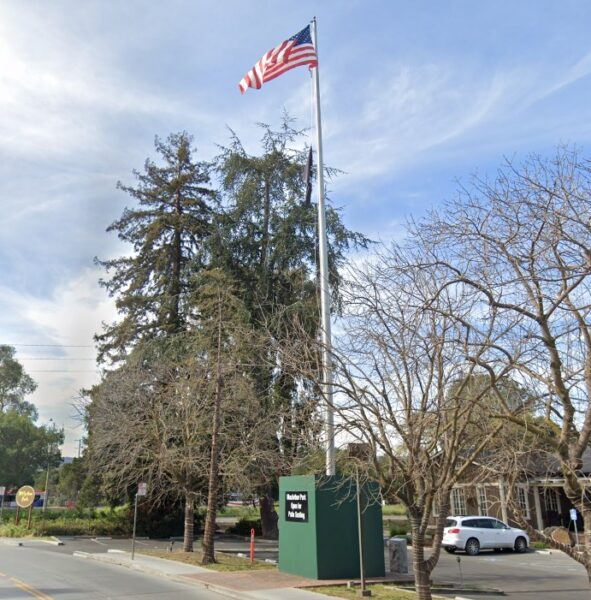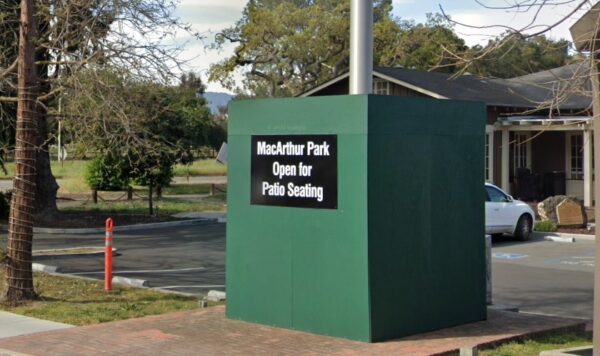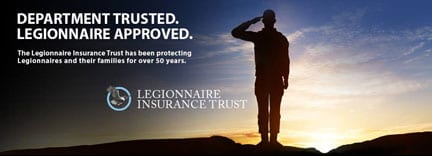
Damage to the Memorial Flagpole at the Veterans Memorial Building, also known as MacArthur Park or the Hostess House, has been hidden from public view. (Photo: Google)
UPDATE: The California Legionnaire has published a recap of the Palo Alto Historic Resources Board’s study session here.
Tomorrow morning, Palo Alto’s Historic Resources Board will hold a study session to review damage to a Veterans memorial with close ties to California American Legion Post 375, and to consider options to restore it.
The Background
Though the exact origins of Palo Alto’s Memorial Flagpole are unclear, a memorial plaque honoring Veterans of the American Civil War and California pioneers suggests it’s been a part of Palo Alto’s history since the early 1900s, if not earlier.
In 1930, Palo Alto’s Memorial Flagpole was moved to the grounds of the historic Veterans Memorial Building, now owned by Stanford University, and the longtime home of Post 375 and other local veterans groups. Since then, local Legionnaires have maintained the flagpole display. That’s why Legionnaires from Post 375 were alarmed to find that in 2020, the memorial plaques were taken down by Stanford due to damage to the Memorial Flagpole’s bronze base.
Soon after, a wooden enclosure was constructed around the Memorial Flagpole’s base to conceal the damage, and over two years later the enclosure still hides the base from public view.
Post 375 Advocates for Protecting the Veterans Memorial Building
Throughout this time, Post 375 has worked with its Stanford counterparts to restore the flagpole. Its commitment can best be summarized in a post resolution that Commander Will von Kaenel read aloud during a joint Veterans Day event the post organized with the city and Stanford University in November last year:
Resolution: Palo Alto’s historic Veterans Memorial Building must be protected, preserved and restored for our veterans
WHEREAS, the Veterans Memorial Building located at 27 University Avenue in Palo Alto, California, is of surpassing historical, cultural, aesthetic and memorial significance, having been entered into the National Register of Historic Places; and
WHEREAS, this historic building was designed by California’s renowned first female architect, Julia Morgan; and
WHEREAS, the building originated from a World War I training camp, and was subsequently dedicated by the City of Palo Alto on Armistice Day 1919 as its World War I Memorial; and
WHEREAS, local veteran associations have used the Veterans Memorial Building continuously since its founding, representing a living testament to its memorial purpose; and
WHEREAS, the visible evidence of the building’s historic and memorial significance to veterans and the local community has receded over recent years; and
WHEREAS, the building and grounds have featured numerous plaques and monuments honoring veterans, demonstrating that its foundational and highest purpose is to serve as Palo Alto’s lasting memorial connecting its citizenry to its veterans; so, therefore be it
RESOLVED, By Post No. 375, The American Legion, Department of California, in regular meeting assembled in Palo Alto on November 3, 2022 that Post No. 375 strongly supports the efforts of all concerned veterans, government agencies, private organizations and citizens to protect, preserve and restore the Veterans Memorial Building’s historical, cultural, aesthetic and memorial heritage.
After consistent back and forth between Post 375 and Stanford University officials, the issue was brought to the Historic Resources Board with both sides agreeing to attend a study session to determine a suitable path to restore the flagpole to its former state.

Google Streetview photos show the wooden enclosure that conceals the damaged flagpole base. (Photo: Google)
Post 375’s efforts also garnered the attention of California Legion Commander Jere Romano, who noted that he will be attending the study session in person to “lend what support the Department can bear on the subject to have the memorial repaired so that it’s available to the public to appreciate.”
The study session will be live-streamed on YouTube tomorrow beginning at 8:15 a.m. Readers can also attend the HRB’s study session by Zoom or teleconference here. Alternatively, written statements can be emailed to hrb@cityofpaloalto.org.
The California Legionnaire will update this story pending the study session’s findings.












